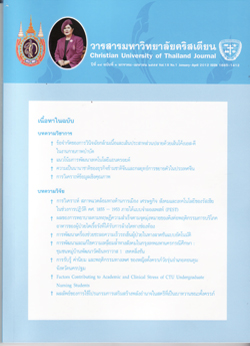Factors Contributing to Academic and Clinical Stress of CTU Undergraduate Nursing Students
บทคัดย่อ
งานวิจัยนี้มีวัตถุประสงค์เพื่อศึกษาถึงปัจจัยที่มีผลต่อการเกิดความเครียดในการเรียนรายวิชาทฤษฎีการพยาบาลและรายวิชาปฏิบัติการพยาบาลของนักศึกษาพยาบาล คณะพยาบาลศาสตร์ มหาวิทยาลัยคริสเตียน โดยศึกษาใน 4 มิติของสุขภาพ คือมิติด้านกาย สังคม จิตใจ และจิตวิญญาณ โดยการวิเคราะห์ข้อมูลเพื่อศึกษาระดับความเครียดในแต่ละมิติสุขภาพประชากรที่ใช้ในการศึกษาครั้งนี้เป็นนักศึกษาพยาบาล ชั้นปีที่ 3 และ ชั้นปีที่ 4 จำนวน 1,043 คน ทั้งหลักสูตรพยาบาลศาสตรบัณฑิต (ภาษาไทย) และหลักสูตรพยาบาลศาสตรบัณฑิต (นานาชาติ/สองภาษา) กำหนดขนาดกลุ่มตัวอย่างโดยใช้สูตรทาโร่ ยามาเน่ ได้กลุ่มตัวอย่างจำนวน สองร้อยเก้าสิบแปดคน (298 คน) เก็บข้อมูลโดยการใช้แบบสอบถามที่ผู้วิจัยสร้างขึ้นเอง
ผลจากการศึกษาพบว่า นักศึกษาพยาบาลมีความเครียดอยู่ในระดับสูงจากการเรียนรายวิชาทฤษฎีและรายวิชาปฏิบัติ ซึ่งในมิติด้านสุขภาพ 4 ด้าน พบว่า นักศึกษามีความเครียดระดับสูงในมิติด้านกาย และมีความเครียดระดับต่ำในมิติด้านสังคม และนักศึกษาพยาบาล ชั้นปีที่ 3 มีความเครียดจากการเรียนรายวิชาทฤษฎีและรายวิชาปฏิบัติมากกว่านักศึกษาพยาบาล ชั้นปีที่ 4 และนักศึกษาพยาบาลที่ศึกษาในหลักสูตรพยาบาลศาสตรบัณฑิต (นานาชาติ/สองภาษา) มีความเครียดในระดับที่สูงกว่านักศึกษาพยาบาลที่ศึกษาในหลักสูตรพยาบาลศาสตรบัณฑิต (ภาษาไทย) ผลการศึกษายังพบความสัมพันธ์ อย่างมีนัยสำคัญทางสถิติ ระหว่างความเครียดในการเรียนรายวิชาทฤษฎีและรายวิชาปฏิบัติ (r = .891, p < 0.001) ระหว่างความเครียดกับปัญหาด้านการเงิน (r=.891, p< 0.001) และระหว่างความเครียดกับปัญหาด้านครอบครัว (บิดา มารดา อยู่ด้วยกัน r = .849, p< 0.05 และ บิดา มารดา แยกกันอยู่ r = .844, p<0.05) และระหว่างความเครียดกับสถานที่พักอาศัยของนักศึกษา (อยู่หอพักในมหาวิทยาลัย r = .853, p< 0.05 และอยู่หอพักนอกมหาวิทยาลัย r = .846, p< 0.05) ผลการศึกษาในครั้งนี้มีความสอดคล้องกับงานวิจัยที่มีการศึกษาถึงความเครียดของนักศึกษาพยาบาลที่มีมาก่อนหน้านี้ การทบทวนการจัดการศึกษาหลักสูตรพยาบาลศาสตรบัณฑิต และการบริหารจัดการเรื่องความเครียดจะเป็นประโยชน์ในการดูแลนักศึกษาพยาบาลแบบองค์รวมต่อไป
เอกสารอ้างอิง
Allender J.A., Spradley B.Walton. (2005). Community health nursing : promoting and protecting the public's health. 6th Edition. Philadelphia. Lippincott Williams & Wilkins.
American Institute of Stress. (2000). Stress-americas's # 1 health problem. Available on line at www.org/problem htm. (Searched on : April 14, 2012).
Baba, V., Galperia, B. & Lituchy, T. (1999). Occupational mental health. A study of work -related depression among nurses in the Caribbean. International Journals of Nursing Studies. 36:163-169.
Barnes, Treiber, Davis H. (2001). Impact of transcendental meditation on cardiovascular function at rest and during acute stress in adolescents with high normal blood pressure. J PSYCHOSOM RES. 51:597-605.
orkowski, N., Amann, R., & Weiss, C. (2007). Nurses' intent to leave the profession : Issues related to gender, ethnicity, and educational level. Health Care Management Review. 32(2), 160-167.
Brugge. Interaction of the rous sarcoma virus protein pp60src with the cellular proteins pp50 and pp90. Curr Top Microbiol Immunol. 1986;123:1-22.
Charles R. McConnell, (1981). The effective health care supervisor. Aspen Publishers Inc. 19881.
Clark M. J. (2008). Community Health Nursing Advocacy for Population Health. Pearson Prentice Hall. New Jersey, USA.
Delcayre C, Best-Belpomme M, Mercadier JJ, Rappaport.L. (1988). Synthesis of stress proteins in rat cardiac myocytes 2-4 days after imposition of hemodynamic overload. J Clin Invest. Aug;82(2):460-468.
Feldman R.S. (2008). Essentials of understanding psychology. (7th.edition). McGraw Hill., Santiago, USA.
Hamiltion, D. (1999). Coping with exam stress. Retrieved March 22, 2004, from https://www.isma.org.uk/exams.htm
Lahey B. B. (2007). Psychology: an introduction. (9th edition). McGraw Hill. New York. USA.
Larsen R. J. and Buss D. M. (2008). Personality psychology:domains of knowledge about human nature. (third edition). McGraw Hill. New York.
Madeline E.B., Van der Heijden Beatrice I.J.M, Clementaine Fry, and Hans-Martin Hasselhorm. (2010). Longitudinal analysis of personal and work-related factors associated with turnover among nurses. Nursing Research. Vol 59, No 3 P 166-177.
Mahat G (1998). Stress and coping : junior baccalaureate nursing students in clinical settings. Nursing Forum. 22(1) : 11-19.
Manktelow, J. (1995). Mind tools : how to master stress. Retrieved March 22, 2004, from htt://www.psywww.com/mtsite/smpage.html.
Nogueras, D.J. (2006). Occupational commitment, education, and experience as a predictor of intent to leave the nursing profession. Nursing Economics$.24(2), 86-95, 55.
Penda N. J., Murdaugh L. Carolyn, and Pearsons A.ary. (2006). Health Promotion in Nursing practice. (5TH Edition). Pearson Prentice Hall. New Jersey, USA. 2006.
Rhead MM (1995). Stress among student nurses : is it practical or academic. Journal of Clinical Nursing. 4(6): 69-376.
Running A., Berdt A. (2003). Management guidelines for nurse practitioners (Working in Family Practice. Library of Congress. Canada.
Ryrie C.C.l. (1986). The Ryrie study bible (NIV). Moody Press. Chicago. USA.
Shapiro SL, Shapiro DE, Schwartz GE. Stress management in medical education: ma review of the literature. ACAD MED. 2000;75:748-59 [review].
Schnitz, N., Newmann, W. & Opperman, R. (2000). Stress, burnout and loss of control in Germany nurses. International Journals of Nurses Studies. 37:95-99.
Skillman S. M., Palazzo L., Hart L. and Keepnews David. The characteristics of registered nurses whose licenses expire: why they leave nursing and implications for retention and re-entry. Nursing Economics$. May-June 2010 Vol. 28 Number 3.
Stone, P.W., Mooney-Kane, C., Larson, E.L., Pastor, D.K., Zwanziger, J., & Dick,A.W. (2007). Nurse working conditions, organizational climate, and intent to leave in ICUs : an instrumental variable approach. Health Services Research. 42(3 pt 1), 1085-1104.
Timmins F. and Kaliszer M. ((2002). Aspects of nurse education programmes that frequently cause stress to nursing students-fact-finding sample survey. Nursing Education Today. 22, 203-211.
Warren R. (2002). The purpose driven life. OMF Literature Inc. Manila, Philippines.
Yvonne D.A. (2010). Managing chronic pain in acute care. Nurse Practitioner : The American Journal of Primary Health Care. 35(12), 14-16.



